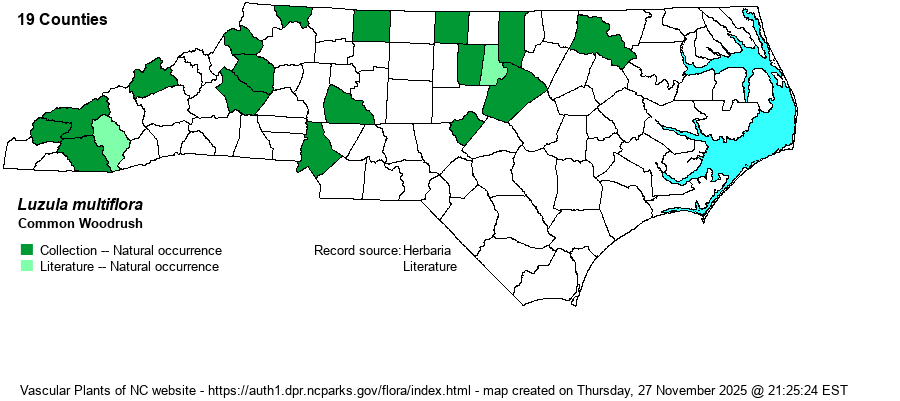| Author | (Ehrhart) Lejeune | |
| Distribution | Scattered occurrences in the Mountains and Piedmont. The species may be overlooked as another species, or simply under-collected, especially as there are records for most of the VA counties (as seen on the Digital Atlas of the Virginia Flora website). On the other hand, several specimens at NCU prove to be bulbosa or echinata. There are no specimens at NCU to voucher Caldwell, Granville, Rowan, Swain, and Watauga counties; they may be at other herbaria and need ID check.
Circumboreal, in N.A. from Newf. to B.C., south to GA and OR. | |
| Abundance | Uncommon to infrequent; not as well known as the other 3 species of Luzula in the state. This is, surprisingly, considered as a Watch List species by the NCNHP; the editors suggest a revised State Rank down to S3?, as opposed to a rarer S2?. | |
| Habitat | Mesic to dry woodlands and forests, fields, forest margins, and roadbanks. | |
| Phenology | Flowering and fruiting late March-July. | |
| Identification | Common Woodrush -- a misnomer here in NC -- rarely exceeds a foot tall. Like L. echinata and L. bulbosa, most leaves are basal and near-basal and wispy-hairy, and the inflorescence has rather short branches. Each head contains 6-20 flowers and is distinctly longer than wide (so also is bulbosa). Common Woodrush and Bulbous Woodrush (L. bulbosa) have strongly ascending or erect branches, versus often spreading on longer branches in Hedgehog Woodrush (L. echinata). From Bulbous Woodrush, it is told by the longer seeds (1.1-1.7 mm vs. 0.9-1.3 mm) and lack of whitish bulblets on roots. | |
| Taxonomic Comments | Weakley (2018) indicates that it is the nominate variety that is found in NC.
| |
| Other Common Name(s) | Heath Woodrush | |
| State Rank | S2? [S3?] | |
| Global Rank | G5 | |
| State Status | [W7] | |
| US Status | | |
| USACE-agcp | FACU link |
| USACE-emp | FACU link |

